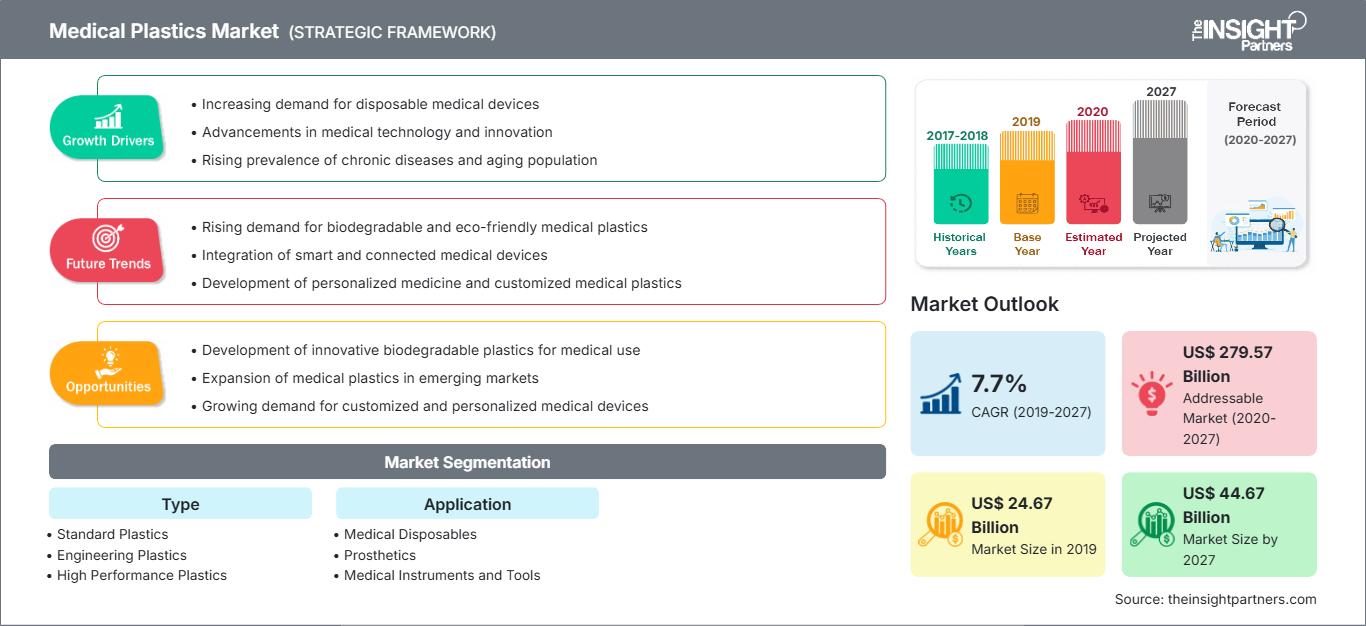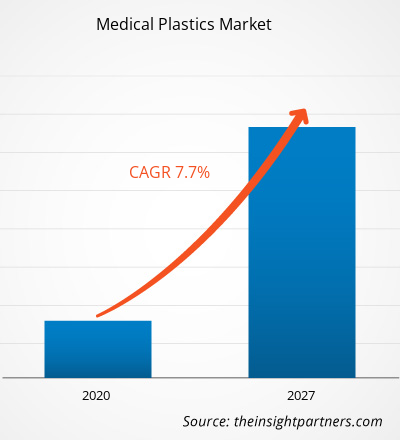Le marché des plastiques médicaux était évalué à 24 671,82 millions de dollars américains en 2019 et devrait atteindre 44 669,63 millions de dollars américains d'ici 2027 ; il devrait croître à un TCAC de 7,7 % entre 2020 et 2027.
Les plastiques médicaux sont fabriqués à partir d'un grand nombre de macromolécules. Ces plastiques sont utilisés pour produire des instruments fiables et sûrs dans le secteur de la santé. Ils sont remarquablement durables, souples et économiques. La performance, la stérilité et la qualité des dispositifs médicaux sont un facteur majeur de croissance du marché. Les plastiques médicaux trouvent un large éventail d'applications dans les instruments de diagnostic, les implants, les produits jetables, les dispositifs d'administration de médicaments, les instruments chirurgicaux, les seringues et les cathéters. La population mondiale devrait augmenter dans les années à venir. Avec cette croissance démographique, les maladies et les infections se propagent rapidement par divers moyens. Français L'augmentation de la population gériatrique favorise encore le développement du secteur de la santé.
Le marché mondial des plastiques médicaux en Asie-Pacifique devrait connaître un TCAC maximal de 8,4 % entre 2020 et 2027. La croissance rapide du marché dans cette région est principalement attribuée à la demande croissante de plastiques médicaux en raison de ses applications dans les produits médicaux jetables, les prothèses, les instruments et outils médicaux et l'administration de médicaments.
La récente épidémie de COVID-19, qui a débuté à Wuhan, en Chine, en décembre 2019, s'est propagée rapidement dans le monde entier. En juin 2020, les États-Unis, la Russie, l'Inde, la Chine, l'Italie, la France et l'Allemagne figuraient parmi les pays les plus touchés en termes de cas positifs et de décès signalés. Selon les chiffres de l'OMS mis à jour en juin 2020, environ 7 482 952 cas confirmés et environ 419 497 décès ont été signalés dans le monde. L'épidémie a affecté les économies et les industries en raison des confinements, des interdictions de voyager et des fermetures d'entreprises décrétés dans plusieurs pays. Le secteur des produits chimiques et des matériaux est l'un des principaux secteurs d'activité mondiaux. Il subit de graves perturbations, telles que des ruptures de chaîne d'approvisionnement, des annulations d'événements technologiques et des fermetures de bureaux, en raison de cette épidémie. La Chine est le centre mondial de la production et le premier fournisseur de matières premières pour diverses industries. La suspension de plusieurs usines et usines en Chine affecte les chaînes d'approvisionnement mondiales et a un impact négatif sur la fabrication et la vente de divers produits chimiques et matériaux. L'effondrement général du marché dû à la pandémie de COVID-19 affecte également la croissance du marché mondial des plastiques médicaux.
Vous bénéficierez d’une personnalisation sur n’importe quel rapport - gratuitement - y compris des parties de ce rapport, ou une analyse au niveau du pays, un pack de données Excel, ainsi que de profiter d’offres exceptionnelles et de réductions pour les start-ups et les universités
Marché des plastiques médicaux: Perspectives stratégiques

-
Obtenez les principales tendances clés du marché de ce rapport.Cet échantillon GRATUIT comprendra une analyse de données, allant des tendances du marché aux estimations et prévisions.
Aperçu du marché : Les nombreux avantages offerts par les plastiques dans les dispositifs médicaux favorisent la croissance du marché à l'échelle mondiale
Les seringues jetables en plastique, les nouvelles valves cardiaques, les poches de sang et plusieurs dispositifs médicaux sont fabriqués en plastique. Pour répondre aux préoccupations croissantes concernant le staphylocoque doré résistant à la méthicilline et autres infections similaires, des polymères de haute technologie, des infections nosocomiales à staphylocoques et des plastiques antimicrobiens ont été développés. Ces plastiques repoussent et tuent la plupart des bactéries, même sur les surfaces fréquemment touchées, et préviennent les infections. De plus, les plastiques antimicrobiens ont une très grande efficacité pour tuer les bactéries, même lorsque les surfaces ne sont pas nettoyées régulièrement. Ainsi, l'utilisation de polymères de haute technologie et de plastiques antimicrobiens dans les dispositifs médicaux contribue à réduire le risque de maladie pour les patients. Grâce à leur grande résistance aux chocs et à leur stabilité thermique, les plastiques techniques remplacent largement le bois ou tout autre matériau utilisé comme manche pour les instruments chirurgicaux. De plus, les plastiques nécessitent moins d'entretien et une stérilisation moins fréquente. Les fabricants délaissent le bois et le métal au profit des plastiques techniques comme le POM, en raison de ses performances supérieures, de son faible coût, de sa non-hygroscopicité et de sa bonne usinabilité.
Aperçu des applications
Le marché des plastiques médicaux est segmenté en fonction des applications : produits médicaux jetables, prothèses, instruments et outils médicaux, administration de médicaments, etc. Ce segment représentait la plus grande part du marché mondial en 2019. Les plastiques sont largement utilisés pour la fabrication d'outils et d'instruments médicaux, tels que les seringues, les gants chirurgicaux, les stylos à insuline, les cathéters, les tubes intraveineux et les dispositifs gonflables. Ces produits sont fabriqués pour un usage unique et contribuent à prévenir la propagation de maladies dangereuses en éliminant la nécessité de réutiliser ou de stériliser un dispositif. Les plastiques sont également utilisés pour créer des surfaces tactiles antimicrobiennes de qualité supérieure qui peuvent repousser les microbes et autres bactéries, réduisant ainsi la propagation de maladies dangereuses.
Marché des plastiques médicauxLes tendances régionales et les facteurs influençant le marché des plastiques médicaux tout au long de la période de prévision ont été analysés en détail par les analystes de The Insight Partners. Cette section aborde également les segments et la géographie du marché des plastiques médicaux en Amérique du Nord, en Europe, en Asie-Pacifique, au Moyen-Orient et en Afrique, ainsi qu'en Amérique du Sud et en Amérique centrale.Portée du rapport sur le marché des plastiques médicaux| Attribut de rapport | Détails |
|---|---|
| Taille du marché en 2019 | US$ 24.67 Billion |
| Taille du marché par 2027 | US$ 44.67 Billion |
| TCAC mondial (2019 - 2027) | 7.7% |
| Données historiques | 2017-2018 |
| Période de prévision | 2020-2027 |
| Segments couverts |
By Type
|
| Régions et pays couverts |
Amérique du Nord
|
| Leaders du marché et profils d'entreprises clés |
|
Densité des acteurs du marché des plastiques médicaux : comprendre son impact sur la dynamique commerciale
Le marché des plastiques médicaux connaît une croissance rapide, portée par une demande croissante des utilisateurs finaux, due à des facteurs tels que l'évolution des préférences des consommateurs, les avancées technologiques et une meilleure connaissance des avantages du produit. Face à cette demande croissante, les entreprises élargissent leur offre, innovent pour répondre aux besoins des consommateurs et capitalisent sur les nouvelles tendances, ce qui alimente la croissance du marché.
- Obtenez le Marché des plastiques médicaux Aperçu des principaux acteurs clés
- Plastiques standard
- Plastiques techniques
- Plastiques haute performance (HPP)
- Silicone
- Autres
Marché des plastiques médicaux, par application
- Produits médicaux jetables
- Prothèses
- Instruments et outils médicaux
- Administration de médicaments
- Autres
Profils d'entreprise
- Celanese Corporation
- Eastman Chemical Company
- GW Plastics
- Orthoplastics Ltd
- ARAN BIOMEDICAL TEORANTA
- Rochling
- SABIC
- Saint-Gobain
- Solvay
- Dow
- Analyse historique (2 ans), année de base, prévision (7 ans) avec TCAC
- Analyse PEST et SWOT
- Taille du marché Valeur / Volume - Mondial, Régional, Pays
- Industrie et paysage concurrentiel
- Ensemble de données Excel
Rapports récents
Rapports connexes
Témoignages
Raison d'acheter
- Prise de décision éclairée
- Compréhension de la dynamique du marché
- Analyse concurrentielle
- Connaissances clients
- Prévisions de marché
- Atténuation des risques
- Planification stratégique
- Justification des investissements
- Identification des marchés émergents
- Amélioration des stratégies marketing
- Amélioration de l'efficacité opérationnelle
- Alignement sur les tendances réglementaires






















 Obtenez un échantillon gratuit pour - Marché des plastiques médicaux
Obtenez un échantillon gratuit pour - Marché des plastiques médicaux